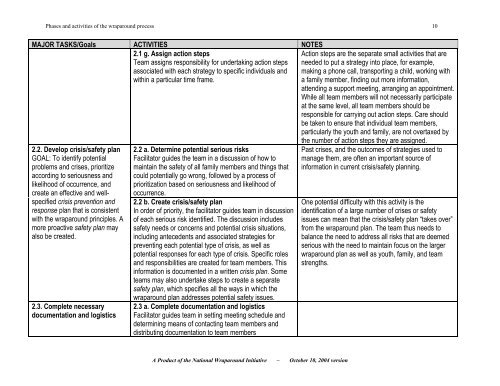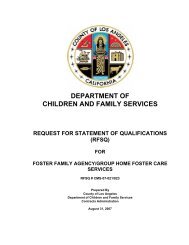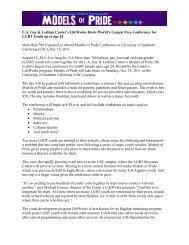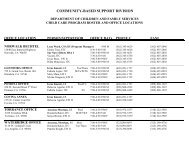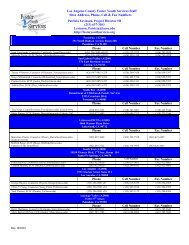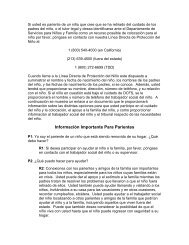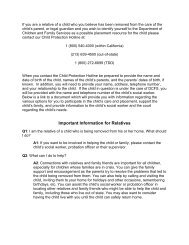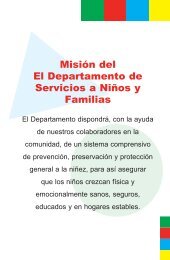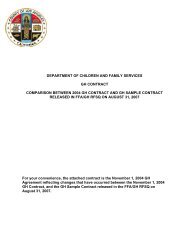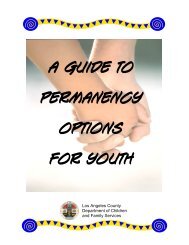Phases and Activities of the Wraparound Process - Los Angeles ...
Phases and Activities of the Wraparound Process - Los Angeles ...
Phases and Activities of the Wraparound Process - Los Angeles ...
Create successful ePaper yourself
Turn your PDF publications into a flip-book with our unique Google optimized e-Paper software.
<strong>Phases</strong> <strong>and</strong> activities <strong>of</strong> <strong>the</strong> wraparound process 10<br />
MAJOR TASKS/Goals ACTIVITIES NOTES<br />
2.2. Develop crisis/safety plan<br />
GOAL: To identify potential<br />
problems <strong>and</strong> crises, prioritize<br />
according to seriousness <strong>and</strong><br />
likelihood <strong>of</strong> occurrence, <strong>and</strong><br />
create an effective <strong>and</strong> wellspecified<br />
crisis prevention <strong>and</strong><br />
response plan that is consistent<br />
with <strong>the</strong> wraparound principles. A<br />
more proactive safety plan may<br />
also be created.<br />
2.3. Complete necessary<br />
documentation <strong>and</strong> logistics<br />
2.1 g. Assign action steps<br />
Team assigns responsibility for undertaking action steps<br />
associated with each strategy to specific individuals <strong>and</strong><br />
within a particular time frame.<br />
2.2 a. Determine potential serious risks<br />
Facilitator guides <strong>the</strong> team in a discussion <strong>of</strong> how to<br />
maintain <strong>the</strong> safety <strong>of</strong> all family members <strong>and</strong> things that<br />
could potentially go wrong, followed by a process <strong>of</strong><br />
prioritization based on seriousness <strong>and</strong> likelihood <strong>of</strong><br />
occurrence.<br />
2.2 b. Create crisis/safety plan<br />
In order <strong>of</strong> priority, <strong>the</strong> facilitator guides team in discussion<br />
<strong>of</strong> each serious risk identified. The discussion includes<br />
safety needs or concerns <strong>and</strong> potential crisis situations,<br />
including antecedents <strong>and</strong> associated strategies for<br />
preventing each potential type <strong>of</strong> crisis, as well as<br />
potential responses for each type <strong>of</strong> crisis. Specific roles<br />
<strong>and</strong> responsibilities are created for team members. This<br />
information is documented in a written crisis plan. Some<br />
teams may also undertake steps to create a separate<br />
safety plan, which specifies all <strong>the</strong> ways in which <strong>the</strong><br />
wraparound plan addresses potential safety issues.<br />
2.3 a. Complete documentation <strong>and</strong> logistics<br />
Facilitator guides team in setting meeting schedule <strong>and</strong><br />
determining means <strong>of</strong> contacting team members <strong>and</strong><br />
distributing documentation to team members<br />
A Product <strong>of</strong> <strong>the</strong> National <strong>Wraparound</strong> Initiative – October 10, 2004 version<br />
Action steps are <strong>the</strong> separate small activities that are<br />
needed to put a strategy into place, for example,<br />
making a phone call, transporting a child, working with<br />
a family member, finding out more information,<br />
attending a support meeting, arranging an appointment.<br />
While all team members will not necessarily participate<br />
at <strong>the</strong> same level, all team members should be<br />
responsible for carrying out action steps. Care should<br />
be taken to ensure that individual team members,<br />
particularly <strong>the</strong> youth <strong>and</strong> family, are not overtaxed by<br />
<strong>the</strong> number <strong>of</strong> action steps <strong>the</strong>y are assigned.<br />
Past crises, <strong>and</strong> <strong>the</strong> outcomes <strong>of</strong> strategies used to<br />
manage <strong>the</strong>m, are <strong>of</strong>ten an important source <strong>of</strong><br />
information in current crisis/safety planning.<br />
One potential difficulty with this activity is <strong>the</strong><br />
identification <strong>of</strong> a large number <strong>of</strong> crises or safety<br />
issues can mean that <strong>the</strong> crisis/safety plan “takes over”<br />
from <strong>the</strong> wraparound plan. The team thus needs to<br />
balance <strong>the</strong> need to address all risks that are deemed<br />
serious with <strong>the</strong> need to maintain focus on <strong>the</strong> larger<br />
wraparound plan as well as youth, family, <strong>and</strong> team<br />
strengths.


